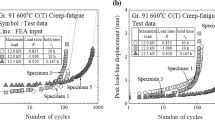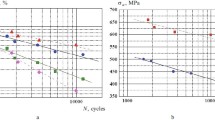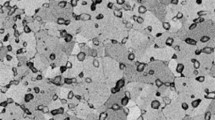Abstract
The closure phenomena of fatigue cracks were investigated with a 1 mm gage length extensometer over the range of stress ratio, R, from −1 to 0.8. Plate specimens with a center slot of HT80 steel and SUS304 stainless steel were fatigued under push-pull loading, and the crack propagation rate, da/dn, was measured. The stress ratio, R, was found to influence da/dn in both materials. The crack opening stress intensity factor, K op, was determined from the relationship between the crack tip extensometer displacement and the load. The effective stress intensity range ratio, U(=ΔKeff/ΔK), decreases with the decrease of the stress intensity amplitude, ΔK/2. As for the data which show the crack closure phenomena (R≦0.4), the relationship between log(da/dn) and log(ΔK eff/2) falls on a straight line near the stress intensity threshold level. For R=0.8 where the crack tip is fully open over the whole range of loading, the data show a discrepancy from the same line. The strain at the crack tip was also measured with the Moiré fringe multiplication method. A large amount of plastic strain at the crack tip was observed even below the crack opening load for R=−1 in HT80 steel. These phenomena show that fatigue damage still exists when the crack is closed. These also show that the crack closure cannot fully account for the effect of R on da/dn.
Résumé
Les phénomènes de fermeture de fissures de fatigue ont été étudiés à l'aide d'un extensomètre d'une longueur de référence d'un millimètre sur une étendue des rapports de contrainte R variant de −1 à +0,8. Les éprouvettes plates comportant un trou central oblong, étaient en acier HT80 et en acier inoxydable SUS304. Elles ont été soumises à fatigue sous des conditions de traction-compression, et la vitesse de propagation de la fissure, da/dn, a été mesurée. Le rapport des tensions R est apparu avoir une influence sur da/dn, dans le cas des deux matériaux. Le facteur d'intensité des contraintes correspondant à l'ouverture de la fissure K op a été déterminé à partir de la relation entre le déplacement de l'extensomètre à l'extrémité de la fissure et la charge. Le rapport effectif de la variation de l'intensité de la contrainte U(=ΔKeff/ΔK) décroit lorsque décroit l'amplitude de l'intensité de contrainte ΔK/2. En ce qui concerne les données montrant le phénomène de fermeture de la fissure (pour R≦0,4) la relation entre log(da/dn) et log(ΔK eff/2) tombe sur une ligne droite au voisinage du niveau de seuil de l'intensité des contraintes. Pour R=0,8 qui correspond à une extrémité d'entaille complètement ouverte quelle que soit la charge, les données montrent une déviation par rapport à cette ligne. La déformation à l'extrémité de la fissure a également été mesurée à l'aide d'une méthode de multiplication des franges de Moiré. On a observé une grande quantité de déformations plastiques à l'extrémité de la fissure, même en dessous de la charge d'ouverture de la fissure correspondant à R=−1 pour l'acier HT80. Ces phénomènes montrent que le dommage par fatigue existe encore lorsque la fissure est refermée. Ils montrent également que la fermeture de la fissure ne peut pas tenir complètement compte de l'effet de R sur da/dn.
Similar content being viewed by others
References
P. Paris and F. Erdogan, Journal of Basic Engineering, 85 (1963) 528–534.
R.G. Forman, V.E. Kearney, and R.M. Engle, Journal of Basic Engineering, 89 (1967) 459–464.
M. Klesnil and P. Lukáš, Material Science of Engineering 9 (1972) 231–240.
P.C. Paris, R.J. Bucci, E.T. Wessel, W.G. Clark and T.R. Mager, Extensive Study of Low Fatigue Growth Rates in A533 and A508 Steels, ASTM STP, 513 (1972) 141–176.
R.J. Cooke and C.J. Beevers, Engineering Fracture Mechanics, 5 (1973) 1061–1071.
A. Ohta and E. Sasaki, International Journal of Fracture, 11 (1975) Reports of Current Research, 1049–1051.
A. Ohta and E. Sasaki, Engineering Fracture Mechanics (1977) 307–315.
W. Elber, The significance of Fatigue Crack Closure, ASTM STP, 486 (1971) 230–242.
H. Nisitani and K. Takao, Transactions of the Japan Society of Mechanical Engineers, 42 (1976) 1964–1974 in Japanese.
R. Koterazawa and S. Minamisaka, Journal of the Society of Materials Science Japan, 26 (1977) 955–961 in Japanese.
M. Kikukawa, M. Jono, K. Tanaka, and M. Takatani, Journal of the Society of Materials Science Japan, 25 (1976) 899–903 in Japanese.
T.T. Shih and R.P. Wei, Engineering Fracture Mechanics, 6 (1974) 19–32.
H. Nisitani and K. Takao, Engineering Fracture Mechanics, 6 (1974) 253–260.
A. Ohta and E. Sasaki, Engineering Fracture Mechanics, 9 (1977) 655–662.
W.F. BrownJr. and E. Stawley, Plane Strain Crack Toughness Testing of High Metallic Materials, ASTM STP, 410 (1976) 1–66.
D. Post, Experimental Mechanics, 8–2 (1968) 63–68.
K. Kato, F. Yamamoto, T. Murota and K. Jinba, Transactions of the Japan Society of Mechanical Engineers, 39–318 (1973) 546–555, in Japanese.
K. Matsumoto and M. Takashima, Applied Optics, 12 (1973) 858–864.
A. Ohta and E. Sasaki, International Journal of Fracture, 13 (1977) 289–300.
Author information
Authors and Affiliations
Rights and permissions
About this article
Cite this article
Ohta, A., Kosuge, M. & Sasaki, E. Fatigue crack closure over the range of stress ratios from −1 to 0.8 down to stress intensity threshold level in HT80 steel and SUS304 stainless steel. Int J Fract 14, 251–264 (1978). https://doi.org/10.1007/BF00034687
Received:
Issue Date:
DOI: https://doi.org/10.1007/BF00034687




